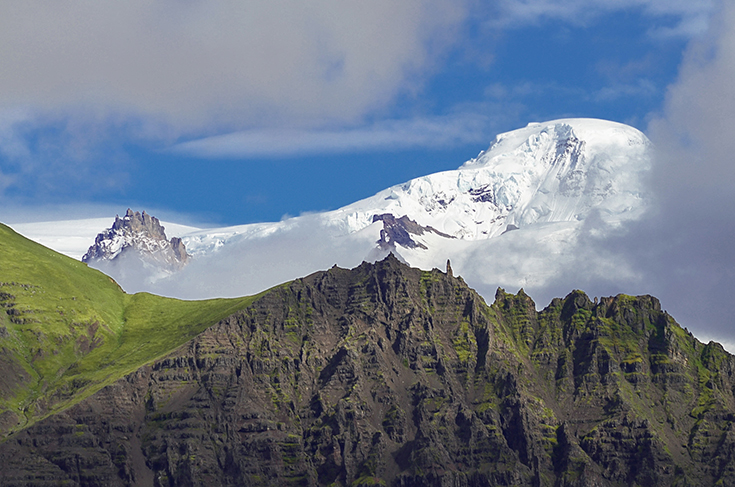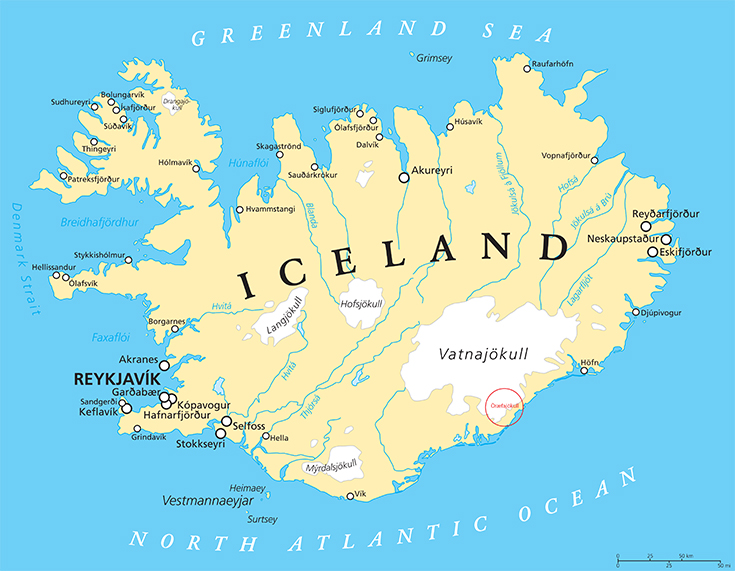Emergency exercise prepares for large volcanic eruption in Iceland
The Icelandic Electric Sectors Emergency Preparedness Forum is organising an emergency response exercise based on the scenario of a large volcanic eruption in Öræfajökull. The exercise will take place on February, 28, 2019.

Öræfajökull lies in the Vatnajökull National Park in Iceland (above and highlighted in red below). Should it erupt, European air travel could experience widespread disruption (Image: Theo Crazzola/Flickr CC)

The subglacial volcano previously erupted in 1362 and in 1727, causing vast devastation to the nearby area and a huge ash cloud. Öræfajökull has been showing similar pre-eruptive behaviour as the volcano Eyjafjallajökull, which erupted in 2010 and caused – among other consequences – widespread disruption of international flights (see CRJ 7:3, Living in the shadows of volcanoes).
Companies from the electricity sector will take part in the exercise, as will the Icelandic Met Office, the Aviation Authority ISAVIA, the Directorate of Health, the Civil Protection Authority, the Road Administration, telecommunication companies and local county administrations, etc. The exercise will run in real time with real emergency communication TETRA and table-top actions.
Scientists from the Icelandic Met Office and the University of Iceland are monitoring the Öræfajökull volcano closely. In July 2018, following a series of meetings, the Department of Civil Protection announced in a statement that the volcano had been: “Showing clear signs of unrest, with an inflation phase,” for at least a year and a half.
“This inflation is ongoing and is reflected by increased seismic activity and characteristic deformation pattern,” it added.
There were no signs of decrease in the inflation rate or the seismicity and the state of unrest was persisting, despite a decrease in geothermal activity. It was likely that the source causing the inflation was most likely the injection of new magma. “The volume change since the start of the unrest is of the order of magnitude of 10 million cubic metres (about 0.2 cubic metres per second), which is comparable to the intrusion activity in Eyjafjallajökull some years before its eruption in 2010.

The Eyjafjallajökull volcanic eruption in 2010 led to evacuations of communities in Iceland and widespread travel disruption (Image: John Helgason/123rf)
This led to the conclusion that Öræfajökull is in a typical preparation stage before an eruption, but the temporal evolution and the outcome is unknown, according to the Department: “Increase in the geothermal activity with associated floods and gas release is a possible scenario.”
Civil Protection and earth scientists have held public information meetings regarding the unrest in Öræfajökull, with both local population and tour operators in the area, and an emergency evacuation plan to be used in case of a sudden eruption was prepared.
Work on a response plan for volcanic eruptions in Öræfajökull is ongoing. The number of instruments for volcano monitoring has been increased on and around the volcano. Natural hazards specialists at the Icelandic Meteorological Office monitor changes in activity, they alert Civil Protection if they detect changes in the volcano´s activity. Telecommunications operators have improved cell phone coverage in the area.
A major eruption in Öræfajökull could paralyse all air traffic across Europe for several days, with resulting cancellations and rescheduled flight disruptions lasting up to two or three weeks, according to a research group at the University of Iceland, led by Dr Uta Reichardt, who has been studying the impact of volcanic eruptions on the aviation sector in Europe.
With thanks to Dóra Hjálmarsdóttir, who helped in the collation of this news story. Read her article on dealing with Iceland's volcanoes from a civil protection perspective in CRJ 7:3 (available to subscribers only)